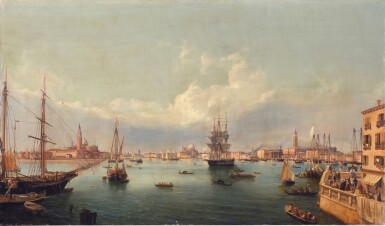Old Masters Evening Auction
Old Masters Evening Auction

Property from a European Private Collection
Federico Moja
The Bacino di San Marco looking West from the Riva San Biasio
Auction Closed
July 6, 06:35 PM GMT
Estimate
100,000 - 150,000 GBP
Lot Details
Description
Property from a European Private Collection
Federico Moja
Milan 1802 - 1885 Dolo
The Bacino di San Marco looking West from the Riva San Biasio
signed and dated on the draped balustrade lower right: F. Moja/ 1847/ VENEZ[IA]
oil on canvas, unlined
81.7 x 139 cm.; 32⅛ x 54¾ in.
---------------------------------------------------
歐洲私人收藏
費德里克・莫哈
1802年生於米蘭,1885年卒於多洛
《從聖比亞西奧河畔西眺聖馬可灣》
款識:藝術家簽名並紀年 F. Moja/ 1847/ VENEZ[IA](右下欄杆之織物上)
油彩畫布
81.7 x 139 公分;32⅛ x 54¾ 英寸
This atmospheric view of Venice was painted in 1847, when Federico Moja was at the height of his artistic career. Born in Milan in 1802 into a family of artists and decorators, Moja started attending the Brera Academy of Fine Arts in 1818, where he rapidly became one of Giovanni Migliara’s most accomplished students, exhibiting regularly from 1824. The influence of his master is evident in his early works, which combine strict teachings in perspective with a taste for romantic themes inspired by the Middle Ages. After a brief stay of four years in Paris, Moja finally moved to Venice in 1841, where he was appointed professor of perspective at the Academy of Fine Arts in 1845. In these years, Moja rapidly established himself as the modern heir to the great tradition of eighteenth-century Venetian view painting.
Here, Moja uses colour to enliven and unify the composition, masterfully capturing the Venetian lagoon. This beautifully preserved view depicts the Bacino di San Marco, animated by a multitude of sailing ships, rowing boats, and even a steamboat in the distance. The boats anchored in the foreground serve to heighten the composition's sense of scale and depth. In the distance, the view encompasses the island of San Giorgio Maggiore with its Palladian church, the Giudecca beyond and the great dome of the Church of the Santissimo Redentore; in the centre, the Punta della Dogana and behind it the imposing domes of the Basilica of Santa Maria della Salute; and to the right, the Palazzo Ducale and the Campanile of San Marco. This view is most likely to have been painted from the Ponte de le Cadene, also known as Ponte de la Veneta Marina, the bridge which marks the entrance to the Bacino from the Arsenale. Along the bustling sidewalk populated by civilians and officers in uniform at the far right, Moja depicts the ‘Caffé alla Veneta Marina’, a renowned Venetian coffeehouse celebrated for its fashionable clientele. According to a local periodical, this is ‘ove le donne piu eleganti e vistose faceano mostra della propria bellezza’ (‘where the most elegant and stylish women would flaunt their beauty’).1 The café also provided the setting for ‘La Donna Astuta’, an opera in two acts by Giuseppe Gazzinga, one of the last Italian composers of opera buffa, first performed at the Teatro San Moisè, Venice, in 1793.
In contrast with other views by the artist, the present work stands out in Moja's œuvre as it offers a much grander, sweeping view of the Bacino. Other examples of his Venetian views, such as the Basilica of Santa Maria della Salute (Galleria d'Arte Moderna, Milan) and the Piazzetta di San Marco at high tide (Private collection), differ in their narrower focus on specific buildings. At the end of his long and distinguished academic career, Moja retired to Dolo in 1875, where he continued to paint views of Milan, Paris and his beloved Venice.
1 G. Secretant, ‘Le istituzioni Veneziane’, in Natura ed Arte, Milan 1898, p. 997.
